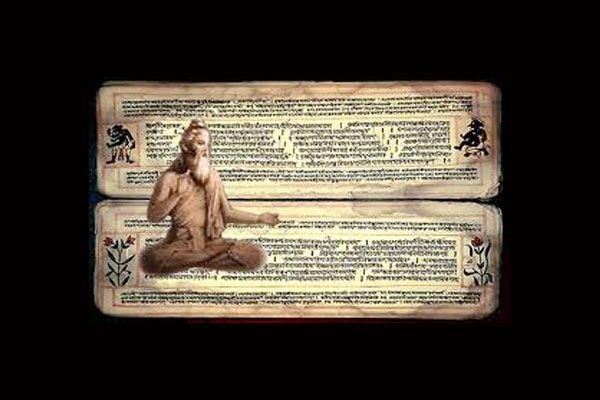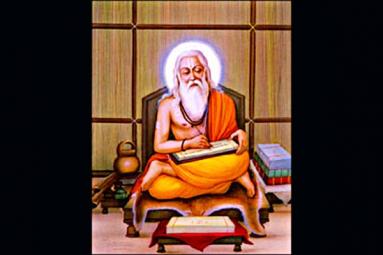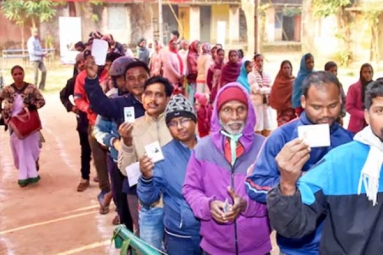
(Image source from: Rugveda})
The Rigveda is an ancient Indian sacred collection of Vedic Sanskrit hymns. It is counted among the four canonical sacred texts of Hinduism known as the Vedas. Some of its verses are still recited as Hindu prayers, at religious functions and other occasions, putting these among the world's oldest religious texts in continued use. The Rigveda contains several mythological and poetical accounts of the origin of the world, hymns praising the gods, and ancient prayers for life, prosperity, etc
The surviving form of the Rigveda is based on an early Iron Age (c. 10th century BC) collection that established the core 'family books' and a later redaction, co-eval with the redaction of the other Vedas, dating several centuries after the hymns were composed. This redaction also included some additions (contradicting the strict ordering scheme) and orthoepic changes to the Vedic Sanskrit such as the regularization of sandhi (termed orthoepische Diaskeuase by Oldenberg, 1888).
As with the other Vedas, the redacted text has been handed down in several versions, most importantly the Padapatha that has each word isolated in pausa form and is used for just one way of memorization; and the Samhitapatha that combines words according to the rules of sandhi (the process being described in the Pratisakhya) and is the memorized text used for recitation.
The Padapatha and the Pratisakhya anchor the text's fidelity and meaning and the fixed text was preserved with unparalleled fidelity for more than a millennium by oral tradition alone. In order to achieve this the oral tradition prescribed very structured enunciation, involving breaking down the Sanskrit compounds into stems and inflections, as well as certain permutations. This interplay with sounds gave rise to a scholarly tradition of morphology and phonetics. The Rigveda was probably not written down until the Gupta period (4th to 6th centuries AD), by which time the Brahmi script had become widespread (the oldest surviving manuscripts date to the Late Middle Ages). The oral tradition still continued into recent times.
The original meaning is close to but not identical to the extant Samhitapatha, but metrical and other observations allow to reconstruct.
Of the Brahmanas that were handed down in the schools of the Bahvrcas (i.e. "possessed of many verses"), as the followers of the Rigveda are called, two have come down to us, namely those of the Aitareyins and the Kaushitakins. The Aitareya-brahmana and the Kaushitaki brahmana evidently have for their groundwork the same stock of traditional exegetic matter. They differ, however, considerably as regards both the arrangement of this matter and their stylistic handling of it, with the exception of the numerous legends common to both, in which the discrepancy is comparatively slight. There is also a certain amount of material peculiar to each of them.
The Kaushitaka is, upon the whole, far more concise in its style and more systematic in its arrangement features which would lead one to infer that it is probably the more modern work of the two. It consists of thirty chapters (adhyaya); while the Aitareya has forty, divided into eight books (or pentads, pancaka), of five chapters each. The last ten adhyayas of the latter work are, however, clearly a later addition though they must have already formed part of it at the time of Panini (c. 5th century BC), if, as seems probable, one of his grammatical sutras, regulating the formation of the names of Brahmanas, consisting of thirty and forty adhyayas, refers to these two works. In this last portion occurs the well-known legend (also found in the Shankhayana-sutra, but not in the Kaushitaki-brahmana) of Shunahshepa, whom his father Ajigarta sells and offers to slay, the recital of which formed part of the inauguration of kings.
While the Aitareya deals almost exclusively with the Soma sacrifice, the Kaushitaka, in its first six chapters, treats of the several kinds of haviryajna, or offerings of rice, milk, ghee, etc., whereupon follows the Soma sacrifice in this way, that chapters 7–10 contain the practical ceremonial and 11–30 the recitations (shastra) of the hotar. Sayana, in the introduction to his commentary on the work, ascribes the Aitareya to the sage Mahidasa Aitareya, also mentioned elsewhere as a philosopher; and it seems likely enough that this person arranged the Brahmana and founded the school of the Aitareyins. Regarding the authorship of the sister work we have no information, except that the opinion of the sage Kaushitaki is frequently referred to in it as authoritative, and generally in opposition to the Paingya—the Brahmana, it would seem, of a rival school, the Paingins. Probably, therefore, it is just what one of the manuscripts calls it the Brahmana of Sankhayana (composed) in accordance with the views of Kaushitaki.




















